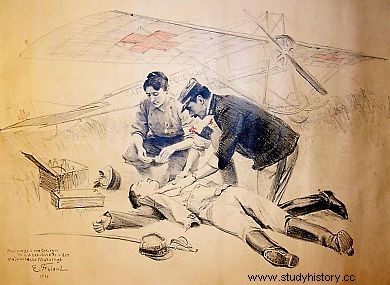Marie Félicie Élisabeth Marvingt (1875 – 1963) was a French sportswoman, pioneer aviator and mountaineer. Adventurous, she has earned many nicknames through her audacity, including that of "the bride of danger".

Four km swim at five years old

Marie Félicie Elisabeth Marvingt was born on February 20, 1875 in Aurillac, in Cantal. Her parents, Élisabeth Brusquin and Félix Marvingt, moved to Metz in 1880 and Marie grew up in Lorraine. She has four siblings, three of whom die in infancy and a fourth at age nineteen. Félix is very fond of sports and passes on his passion to his daughter, particularly in swimming, mountaineering and canoeing. At five years old, she is able to swim four kilometers. At fifteen, she crossed 400 kilometers by canoe between Nancy and Koblenz. When Marie was fourteen, her mother died and she and her father moved to Nancy. She became a domestic worker there, without ceasing her many sports activities.
The Tour de France cyclist
Attracted by the circus world, Marie Marvingt trained at the Rancy circus and learned aerobatics, trapeze, juggling and tightrope walking. Passionate about sports and encouraged by her father, she also practices cycling, skiing, skating, fencing, gymnastics and other sports. In 1899, she was one of the first women to obtain a driver's license. In 1905, Marie became the first woman to swim across Paris in the Seine. During this period, she won numerous prizes in swimming, canoeing, shooting, skiing, skating… A confirmed mountaineer, she climbed most of the peaks of the French and Swiss Alps in a few years. In 1908, Marie tried to participate in the Tour de France cyclist, but her candidacy was rejected. Determined not to be discouraged by this refusal, she nevertheless completed the same course as the men, taking a staggered start.
"Daredevil Mary"
Quickly, Marie Marvingt also became interested in the world of aviation and passed a first balloon pilot's license in 1909, then airplane and seaplane in 1910; she is the third woman in history to obtain this patent. In this discipline again, she won numerous prizes and set records, particularly in flight time and number of flight hours without accident. In October 1909, she became the first woman to fly an aircraft over the North Sea and the English Channel, flying to England from Nancy. A few accidents and somewhat rough landings did not dampen his enthusiasm for the air world.
In 1910, Marie became interested in the possibility of transporting the wounded by air and created a first prototype for medical aviation. It will not see the light of day, but the principle will be taken up later. Very noted for her audacity, her skill and her skill, at a time when women were rather confined to the interior of homes, she became the darling of the press who nicknamed her "Marie daredevil", "the queen of the 'air', 'the tireless globetrotter' or even 'the most extraordinary woman since Joan of Arc'.
At the front with the men
 At the start of the First World War, Marie Marvingt offered her services as a pilot but, like all other female pilots in her case, she is refused. She then works on the front as a nurse, until a young lieutenant helps her pass herself off as a man to participate in the fighting. She then fights in the trenches until she is unmasked and sent home. Decided despite everything to participate in the war, she obtained, with the intervention of Marshal Foch, the authorization to join the Alpine hunters in Italy. It then carried out missions to repatriate wounded soldiers, as well as bombardments. In 1915, she received the Croix de Guerre for a bombing mission and became the first woman to enlist in military aviation.
At the start of the First World War, Marie Marvingt offered her services as a pilot but, like all other female pilots in her case, she is refused. She then works on the front as a nurse, until a young lieutenant helps her pass herself off as a man to participate in the fighting. She then fights in the trenches until she is unmasked and sent home. Decided despite everything to participate in the war, she obtained, with the intervention of Marshal Foch, the authorization to join the Alpine hunters in Italy. It then carried out missions to repatriate wounded soldiers, as well as bombardments. In 1915, she received the Croix de Guerre for a bombing mission and became the first woman to enlist in military aviation.
Medical aviation
At the end of the war, convinced of the importance of medical aviation, Marie Marvingt traveled the world to give lectures on the subject and create air medical services. In 1935, she became the first flight nurse to graduate. The same year, she was made a Knight of the Legion of Honor. Also a graduate in literature and speaking seven languages, she worked between the wars as a journalist and war correspondent in North Africa. During the Second World War, in the continuity of her commitment, she officiated as the air nurse. After the war, Marie wrote and directed two documentaries on medical aviation, The Wings that Save and Saved by the Dove. In 1955, at the age of 80, Marie passed her helicopter pilot's license on a jet helicopter, a SNCASO SO-1221 Djinn. At 86, she travels to Paris from Nancy by bike, then returns to Nancy at the controls of a helicopter.
Holder of seventeen world records and thirty-four decorations including the Legion of Honor, "the bride of danger", "the most extraordinary woman of the century", ends her life in destitution, and dies in anonymity December 14, 1963, in the suburbs of Nancy. His exploits have since fallen into oblivion.
